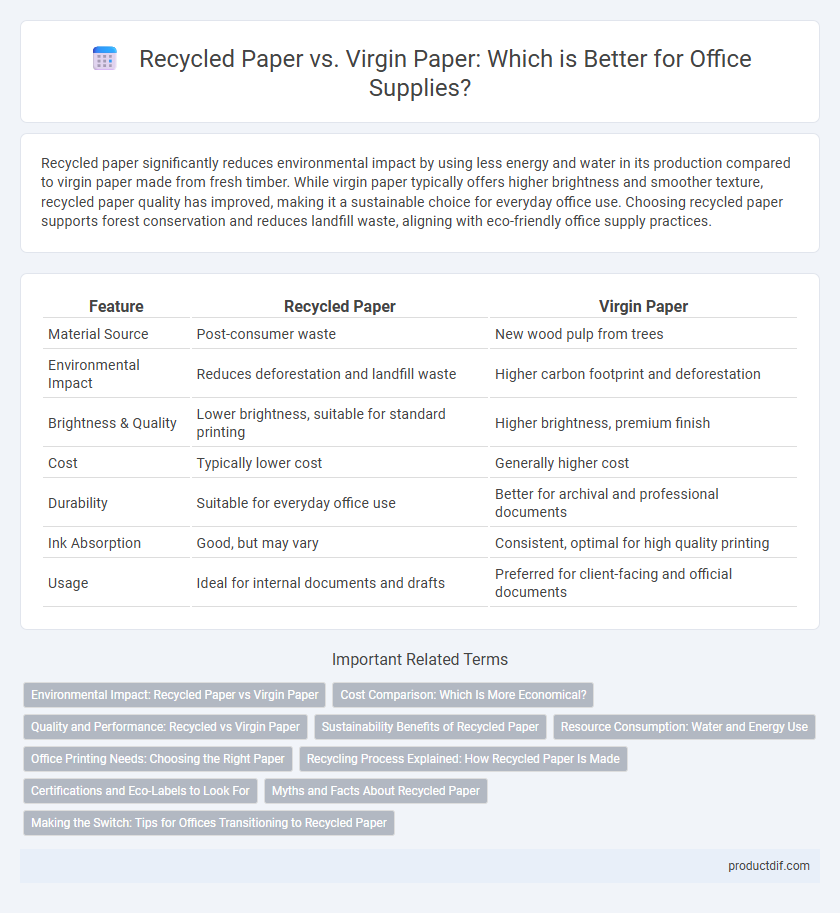Recycled paper significantly reduces environmental impact by using less energy and water in its production compared to virgin paper made from fresh timber. While virgin paper typically offers higher brightness and smoother texture, recycled paper quality has improved, making it a sustainable choice for everyday office use. Choosing recycled paper supports forest conservation and reduces landfill waste, aligning with eco-friendly office supply practices.
Table of Comparison
| Feature | Recycled Paper | Virgin Paper |
|---|---|---|
| Material Source | Post-consumer waste | New wood pulp from trees |
| Environmental Impact | Reduces deforestation and landfill waste | Higher carbon footprint and deforestation |
| Brightness & Quality | Lower brightness, suitable for standard printing | Higher brightness, premium finish |
| Cost | Typically lower cost | Generally higher cost |
| Durability | Suitable for everyday office use | Better for archival and professional documents |
| Ink Absorption | Good, but may vary | Consistent, optimal for high quality printing |
| Usage | Ideal for internal documents and drafts | Preferred for client-facing and official documents |
Environmental Impact: Recycled Paper vs Virgin Paper
Recycled paper significantly reduces deforestation by reusing fibers, thereby conserving natural habitats and biodiversity compared to virgin paper, which relies on freshly harvested timber. The production of recycled paper typically consumes 40-70% less energy and emits fewer greenhouse gases, making it a more sustainable choice for office supplies. Additionally, recycled paper reduces landfill waste and water usage, contributing to lower overall environmental footprints in paper manufacturing.
Cost Comparison: Which Is More Economical?
Recycled paper typically costs less than virgin paper due to lower raw material expenses and reduced energy consumption during production. Virgin paper involves higher costs linked to logging, pulping fresh fibers, and more intensive processing, making it less economical for large-scale office use. Businesses aiming to minimize office supply expenses benefit from choosing recycled paper, which combines cost savings with environmental advantages.
Quality and Performance: Recycled vs Virgin Paper
Recycled paper often matches virgin paper in quality, offering comparable brightness, opacity, and smoothness suitable for most office tasks, while virgin paper tends to provide superior strength and durability essential for high-end printing and archival purposes. Performance differences include recycled paper's slightly higher fiber variability, which can affect ink absorption and print sharpness, whereas virgin paper ensures consistent texture and color vibrancy. Selecting between recycled and virgin paper depends on specific office needs, balancing environmental benefits with professional output requirements.
Sustainability Benefits of Recycled Paper
Recycled paper significantly reduces deforestation and conserves natural resources by reusing existing fibers, leading to lower energy consumption and greenhouse gas emissions compared to virgin paper production. It minimizes landfill waste and supports circular economy principles, enhancing overall environmental sustainability in office supply chains. Choosing recycled paper contributes to carbon footprint reduction and promotes responsible forest management, aligning with corporate sustainability goals.
Resource Consumption: Water and Energy Use
Recycled paper significantly reduces resource consumption compared to virgin paper by using up to 60% less water and 40% less energy during production. Virgin paper requires extensive water usage for pulping raw timber and high energy input for processing fresh fibers. Choosing recycled paper supports sustainable office practices by minimizing environmental impact through efficient resource utilization.
Office Printing Needs: Choosing the Right Paper
Recycled paper offers an eco-friendly choice for office printing needs, reducing environmental impact by reusing fibers and lowering energy consumption compared to virgin paper. Virgin paper, made from new wood pulp, often provides higher brightness and smoother texture, ideal for high-quality presentations and professional documents. Selecting the right paper depends on balancing sustainability goals with print quality requirements and budget constraints in the office environment.
Recycling Process Explained: How Recycled Paper Is Made
Recycled paper is produced by collecting used paper, which is then sorted, cleaned, and de-inked through a pulping process to remove contaminants and inks. The cleaned pulp undergoes refining, bleaching, and drying before being formed into new sheets, reducing the demand for virgin wood fibers. This recycling process conserves natural resources, reduces landfill waste, and lowers energy consumption compared to producing virgin paper from fresh timber.
Certifications and Eco-Labels to Look For
Certifications such as FSC (Forest Stewardship Council) and PEFC (Programme for the Endorsement of Forest Certification) are crucial indicators of sustainable sourcing in both recycled and virgin paper. Eco-labels like Green Seal and EU Ecolabel further ensure that recycled paper meets stringent environmental standards, reducing carbon footprint and water usage. Selecting paper with these certifications supports responsible forest management and promotes reduced environmental impact in office supply choices.
Myths and Facts About Recycled Paper
Recycled paper is often perceived as lower quality compared to virgin paper, but modern recycling processes produce sturdy, high-quality sheets suitable for various office tasks. Contrary to myths, recycled paper can be bleached without chlorine to achieve bright whiteness, reducing environmental impact while maintaining appearance. Studies show recycled paper manufacturing uses significantly less water and energy, lowering the carbon footprint compared to virgin paper production.
Making the Switch: Tips for Offices Transitioning to Recycled Paper
Switching to recycled paper in offices reduces environmental impact by saving trees and decreasing energy consumption during production. To ensure a smooth transition, test recycled paper quality in printers and copiers to avoid jams or print clarity issues. Communicate sustainability goals with staff and source suppliers that provide certified recycled paper meeting office performance standards.
Recycled paper vs Virgin paper Infographic

 productdif.com
productdif.com